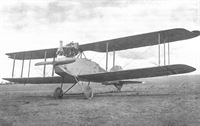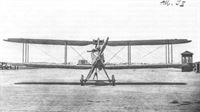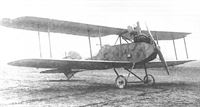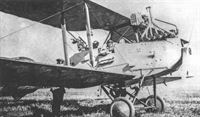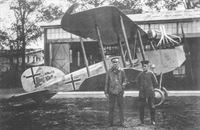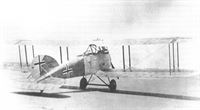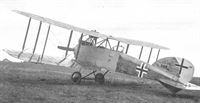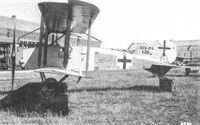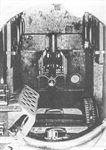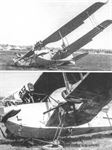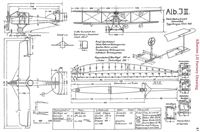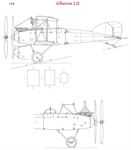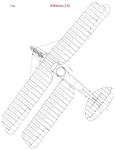
Описание
Страна: Германия
Год: 1918
Варианты
- Albatros - J.I - 1917 - Германия
- Albatros - J.II - 1918 - Германия
- O.Thetford, P.Gray German Aircraft of the First World War (Putnam)
- J.Herris Albatros Aircraft of WWI. Vol.3: Bombers, Seaplanes, J-types (A Centennial Perspective on Great War Airplanes 26)
-
J.Herris - Albatros Aircraft of WWI. Volume 3: Bombers, Seaplanes, J-types /Centennial Perspective/ (26)
Albatros J.II J.126/18. This aircraft was photographed either with no exhaust or the exhaust was angled downward.
-
J.Herris - Development of German Warplanes in WWI /Centennial Perspective/ (1)
The Albatros J.II had an armored engine, solving the worst problem of the Albatros J.I. This one is in standard factory finish.
-
J.Herris - Albatros Aircraft of WWI. Volume 3: Bombers, Seaplanes, J-types /Centennial Perspective/ (26)
Albatros J.II, serial unknown, in late-war irregular camouflage pattern. This particular pattern was illustrated in drawings made of tribute aircraft sent to Japan in 1919.
-
J.Herris - Albatros Aircraft of WWI. Volume 3: Bombers, Seaplanes, J-types /Centennial Perspective/ (26)
The Albatros J.II was redesigned to improve survivability in the hostile environment in which it flew its missions. Most importantly, the entire engine was now armored, solving the worst problem with the J.I. In addition, unlike the J.I, the radiator was now armored, further improving survivability. Finally, the upper ailerons were given aerodynamic horn balances to reduce control pressures for better maneuverability. The same basic Benz engine was used, but power was boosted 10% to 220 hp to compensate for the greater weight of the engine armor, which accounted for the boxy cowling. The result was a more robust, survivable aircraft with essentially the same performance despite its greater weight.
-
J.Herris - Albatros Aircraft of WWI. Volume 3: Bombers, Seaplanes, J-types /Centennial Perspective/ (26)
Albatros J.II at the factory, perhaps 127/18. Despite its boxy shape due to construction from armored plates, care has been taken to minimize frontal area to keep drag in check. Two fixed guns firing downward protrude from the bottom of the fuselage. A guard shack painted in stripes is in the right background and the airship hangar is behind the aircraft.
-
J.Herris - Albatros Aircraft of WWI. Volume 3: Bombers, Seaplanes, J-types /Centennial Perspective/ (26)
Another view of the same Albatros J.II shows more of its nose. With its armored engine and radiator, the J.II was much more likely to survive being hit by rifle-caliber ground fire than its J.I predecessor.
-
J.Herris - Albatros Aircraft of WWI. Volume 3: Bombers, Seaplanes, J-types /Centennial Perspective/ (26)
Some Albatros J.II aircraft had the fuselage camouflage seen on some J.I aircraft and illustrated in color by the Japanese artist. No unit or personal markings are visible; the tires are missing due to the rubber shortage.
-
J.Herris - Albatros Aircraft of WWI. Volume 3: Bombers, Seaplanes, J-types /Centennial Perspective/ (26)
Albatros J.II ready for a mission clearly showing the downward-firing guns and observer's flexible gun. The wind-driven dynamo for the wireless is on the front undercarriage strut, and the leads for the antenna are below the fuselage.
-
J.Herris - Albatros Aircraft of WWI. Volume 3: Bombers, Seaplanes, J-types /Centennial Perspective/ (26)
Albatros J.II 140/18 serves in basic factory finish and markings; no unit or personal markings are visible.
-
J.Herris - Albatros Aircraft of WWI. Volume 3: Bombers, Seaplanes, J-types /Centennial Perspective/ (26)
This rearview of the Albatros J.II displays its standard factory finish and markings. Printed camouflage fabric covers all flying surfaces, the armor is painted light gray, and the wood rear fuselage and fin are varnished.
-
J.Herris - Albatros Aircraft of WWI. Volume 3: Bombers, Seaplanes, J-types /Centennial Perspective/ (26)
Albatros J.II 127/18 is shown here in its basic factory finish and markings. Flying surfaces are covered with printed camouflage fabric, the armor is painted light gray, and the wood rear fuselage and fin are clear-varnished.
-
J.Herris - Albatros Aircraft of WWI. Volume 3: Bombers, Seaplanes, J-types /Centennial Perspective/ (26)
Albatros J.II 126/18 serves in basic factory finish and markings; no unit or personal markings are visible.
-
J.Herris - Albatros Aircraft of WWI. Volume 3: Bombers, Seaplanes, J-types /Centennial Perspective/ (26)
Albatros J.II ready for a mission.
-
J.Herris - Albatros Aircraft of WWI. Volume 3: Bombers, Seaplanes, J-types /Centennial Perspective/ (26)
This postwar view of German aircraft sent to Italy as reparations shows an Albatros J.II in the middle with the same pattern of fuselage camouflage seen above, another indication it was applied at the factory.
-
R.Bennett - Last Gathering of Eagles 1918-1920 /Aeronaut/
The Inter-Allied Baltic Commission intercepted a shipment of German aircraft on its arrival in East Prussia and returned it to Lithuania. This train carried LVG C.VI 12017/18 (ex-FA 433), Halb. C.V (Av) 6859/18, Alb. D.III (OAW) D.5160/17, LVG C.V 9652/17, one DFW C.V, and three Alb. J.IIs. (Moshe Bukhman)
Другие самолёты на фотографии: Albatros D.III - Германия - 1916DFW C.V - Германия - 1916Halberstadt C.V/C.IX - Германия - 1918LVG C.V - Германия - 1917LVG C.VI - Германия - 1918
-
J.Herris - Albatros Aircraft of WWI. Volume 3: Bombers, Seaplanes, J-types /Centennial Perspective/ (26)
The 20mm Becker cannons fitted to the Albatros J.Is proved to be effective anti-tank weapons, and 20 Albatros J.II aircraft were fitted with these weapons in an improved mount in the floor of the gunner's cockpit shown here; the front of the aircraft is at the top of the photo. Extra magazines for the Becker are stacked on the sides of the armored cockpit and extra drums of machine gun ammunition are stored at the rear. Twenty AEG J.II aircraft were delivered with a similar Becker installation.
-
J.Herris - Albatros Aircraft of WWI. Volume 3: Bombers, Seaplanes, J-types /Centennial Perspective/ (26)
Albatros J.II after a landing accident; the downward-firing guns are barely visible under the fuselage.
-
J.Herris - Albatros Aircraft of WWI. Volume 3: Bombers, Seaplanes, J-types /Centennial Perspective/ (26)
Albatros J.II Factory Drawing
O.Thetford, P.Gray German Aircraft of the First World War (Putnam)
Albatros J II
This aircraft was an improvement on the J I, with the armour extended forward to enclose the engine. At least four examples were built, numbered 126/18, 133/18, 167/18 and 169/18, but in view of the success of the Junkers J I, it is doubtful if many more existed. The downward twin machine-guns may be seen in the photograph protruding through the floor between the undercarriage legs. This arrangement was subsequently abandoned due to difficult and inaccurate sighting at low altitude. Engine, 220 h.p. Benz IVa. Span, 13.55 m. (44 ft. 5 1/2 in.). Length, 8.433 m. (27 ft. 8 in.). Height, 3.4 m. (11 ft. 1 7/8 in.). Area, 43.2 sq.m. (466.56 sq.ft.). Weights: Empty, 1,027 kg. (2,259 lb.). Loaded, 1,927 kg. (4,239 lb.). Speed, 140 km.hr. (87.5 m.p.h.). Climb, 1,000 m. (3,280 ft.) in 8.7 min. Duration, 2.5 hr. Armament, two fixed Spandau machine-guns, one manually operated Parabellum machinegun in rear cockpit.
Описание:





